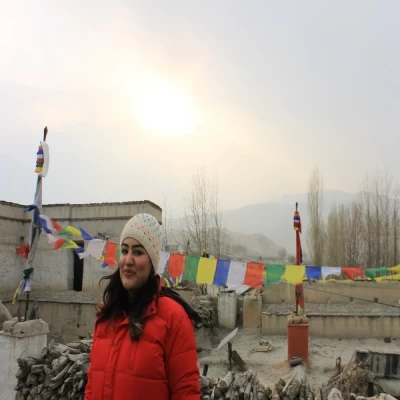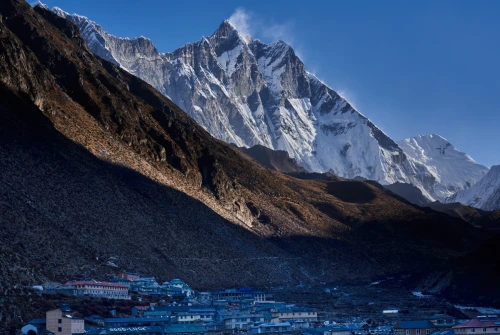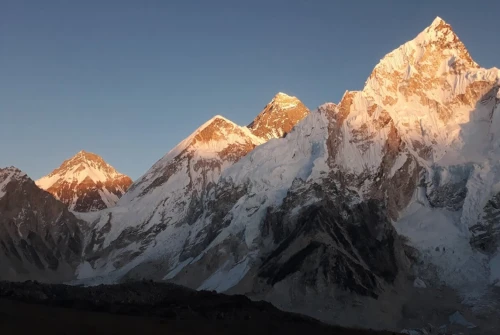Overview: Food and Accommodation in the Everest Base Camp Trek
The Everest Base Camp Trek is a journey that takes us deep into the heart of the Himalayas, offering not only dramatic landscapes and high-altitude adventure but also a diverse range of flavors and comforts along the trail. Whether we're trekking on a shoestring budget or opting for a more lavish experience, the food we eat and the places we stay can define our overall experience. Below, we explore in-depth what we can expect from both food and accommodation throughout the Everest Base Camp Trek, catering to every type of traveler.
Trekking to Everest Base Camp is more than just a walk through the majestic Himalayas; it's an immersive journey through Nepal’s mountain culture, and food and accommodation play a vital role in shaping that experience. From the moment we begin our trek in Lukla to the time we reach Gorakshep near Base Camp, we encounter a wide range of culinary and lodging options. Whether we’re enjoying a humble plate of Dal Bhat at a wooden teahouse or resting in a warm, high-end lodge with mountain views, each moment adds depth to our Himalayan adventure. Every village along the trail presents a unique combination of culture, comfort, and cuisine, and understanding these choices ahead of time helps us trek more wisely and enjoyably.
Food on the Everest Base Camp is a mix of tradition and necessity. Local dishes like Dal Bhat, Sherpa stew, and Tibetan bread are designed to provide warmth and sustained energy for trekkers tackling long, high-altitude days. Western items like pasta, toast, pancakes, and fried rice are widely available, especially in busier villages like Namche Bazaar and Dingboche, though menu variety declines the higher we climb. Water safety and hydration are equally critical, and while bottled water and hot drinks are available, many trekkers choose eco-friendly purification methods. For those with dietary restrictions, vegetarian options are readily available, although special diets may require additional preparation. Carrying protein snacks, nuts, or personal supplements is a smart way to stay nourished throughout the trek.
When it comes to lodging, the Everest region caters to a full spectrum of trekking preferences—from minimalist backpackers to luxury seekers. Budget teahouses are basic but authentic, offering twin beds, shared toilets, and a communal fireplace where we meet fellow adventurers. Mid-range lodges strike a comfortable balance, often with private rooms and better facilities like hot showers and Wi-Fi. Meanwhile, luxury lodges in select locations offer premium comfort, including heated rooms, en-suite bathrooms, gourmet meals, and impeccable service. As we ascend, amenities become limited, prices increase, and simplicity becomes the norm. But regardless of where we sleep or what we eat, every stop on the Everest Base Camp trail becomes a cherished chapter in the journey—one that nourishes the body, supports the spirit, and connects us deeply to the mountains and the people who call them home.
Traditional Himalayan Meals
As we ascend through the Khumbu region, we find ourselves increasingly relying on wholesome, local meals designed to fuel trekkers through cold nights and steep ascents. The most iconic among them is Dal Bhat, a hearty platter of steamed rice, lentil soup, seasonal vegetables, and occasionally curried meat. This meal is a staple of the Sherpa diet and is known for its nutritional value and the beloved tradition of unlimited refills. Beyond Dal Bhat, we savor other traditional dishes like Tibetan bread, a fried flatbread often served with jam or honey; Sherpa stew (Syakpa), a thick soup made from hand-cut noodles and vegetables; and Tsampa porridge, made from roasted barley flour, which offers a strong energy boost. These meals are often cooked fresh with local produce and help us adjust to high-altitude nutrition needs.
Western Food Options Available
For trekkers craving familiar comfort food, most teahouses—especially in villages like Namche Bazaar and Dingboche—offer a variety of western-inspired dishes. We can enjoy items such as pasta with tomato or cheese sauce, fried rice or noodles, pancakes, boiled eggs, toast with peanut butter or jam, and even basic pizzas and burgers at lower altitudes. Breakfast typically includes options like muesli, porridge, chapati, or omelets. While these may not mirror what we're used to at home, they are surprisingly satisfying after long hiking days. It's important to note that as we gain elevation, the variety shrinks and prices climb due to the difficulty of transporting ingredients. However, these comforting dishes can provide a psychological and physical boost during the trek.
Drinks on the Everest Base Camp Trek
Staying properly hydrated is essential while trekking to Everest Base Camp, especially at high altitudes where dehydration can increase the risk of altitude sickness. Throughout the trail, a variety of hot and cold drinks are available at teahouses and lodges to keep us refreshed and energized. Popular hot drinks include ginger tea, lemon honey tea, masala tea, mint tea, and garlic soup, which is often recommended for acclimatization. We can also find instant coffee, black tea, hot chocolate, and even Yak butter tea, a traditional Sherpa drink. Bottled water is widely sold but becomes expensive and environmentally problematic as we go higher, so many trekkers choose to fill their bottles with boiled water (available at teahouses for a small fee) or use water purification tablets or filters. Though soft drinks and energy beverages like Coke, Fanta, and Red Bull are available in lower villages, they are not ideal for hydration. Alcoholic drinks such as local Raksi or Tongba may be found in some areas, but it's strongly advised to avoid alcohol during the trek due to its dehydrating effects and negative impact on altitude adjustment.
Dietary Restrictions and Vegetarian Options
Trekking through the Himalayas with dietary restrictions is entirely possible, as vegetarian meals are widely available and even recommended above certain altitudes. Due to the lack of refrigeration and ethical concerns, meat is best avoided beyond Namche Bazaar, since it’s carried by porters from lower altitudes and is rarely fresh. Vegetarian dishes like vegetable fried rice, noodles, Dal Bhat, soups, and potato-based meals are safe, filling, and nutritious. While gluten-free and vegan options are more limited, we can manage with some preparation. It’s wise to bring energy bars, nuts, dried fruits, protein powder, or other personal supplements to meet dietary needs and energy requirements, especially in remote areas where menu variety is narrow.
Teahouse Accommodation on EBC Trek
Teahouses are the most common and traditional form of accommodation along the Everest Base Camp trek. These family-run lodges offer basic but warm shelter, making them an essential part of the trekking experience. Rooms usually consist of wooden walls, twin beds with foam mattresses, and shared bathrooms, though attached toilets are sometimes available in lower villages. The dining area is typically the heart of the teahouse, a communal space heated by a yak-dung stove, where trekkers from around the world gather to eat, chat, and stay warm. Teahouse standards vary depending on altitude and location; the lower villages like Phakding, Namche Bazaar, and Tengboche offer slightly more comfortable amenities, while higher-altitude stops like Lobuche and Gorakshep tend to be more basic due to their remoteness. Despite their simplicity, teahouses are incredibly welcoming and give us a genuine glimpse into the local Sherpa lifestyle. Most include a restaurant-style kitchen, a limited but nutritious menu, and charging facilities (for a fee). While hot showers and Wi-Fi are available in some places, they usually cost extra, and availability decreases the higher we go.
Budget Teahouses: Basic Yet Authentic
For Everest Base Camp budget trekkers, basic teahouses offer a no-frills yet culturally rich experience. These accommodations, found in nearly every village from Lukla to Gorakshep, consist of simple wooden rooms with twin beds, shared bathrooms (usually squat toilets), and a communal dining hall warmed by a yak-dung stove. Blankets are typically provided, but we should carry our own sleeping bag rated for sub-zero temperatures, especially in high-altitude villages. Amenities are minimal, and showers or power outlets may cost extra or not be available at all. Still, these teahouses provide a warm welcome, hot meals, and a genuine opportunity to interact with local Sherpa families and fellow trekkers from around the globe.
Mid-Range Lodges: Comfort with Value
If we’re looking for something a little more comfortable without stepping into luxury territory, mid-range lodges strike the perfect balance. These lodges can be found in popular stopovers like Namche Bazaar, Tengboche, and Dingboche, and typically offer private rooms with softer beds, better insulation, attached or semi-attached bathrooms, and hot showers (though often for an additional fee). The food variety is wider, and some places even offer Wi-Fi and mobile charging. While not luxurious by city standards, these lodges offer a much-needed level of convenience, especially after several hard days on the trail. They are ideal for trekkers who prioritize comfort, privacy, and better service, yet still want an authentic Himalayan trekking experience.
Luxury Lodges: Trekking in Style
For those seeking premium comfort without compromising the thrill of trekking, the luxury Everest Base Camp trek offers a surprisingly refined experience. Found primarily in lower altitudes like Lukla, Monjo, Namche, and Debuche, properties like Yeti Mountain Home or Everest Summit Lodge come with features such as ensuite western-style bathrooms, electric blankets, heated rooms, gourmet meals, and five-star service. These lodges cater to clients who value comfort, cleanliness, and personalized hospitality. Often paired with guided tours, helicopter returns, or personal porters, luxury trekking packages are more expensive but perfect for those short on time or hesitant about the rigors of high-altitude travel. While not available at the highest altitudes like Gorakshep, the experience up to Pangboche or Dingboche can be nothing short of exceptional.
Camping Accommodation on EBC Trek
While teahouses dominate the standard trekking experience, camping on the Everest Base Camp trek offers a more immersive and adventurous alternative. Camping is especially popular among expedition teams, off-season trekkers, or those exploring remote trails off the main route, such as the Three Passes or Gokyo Valley. This option requires full logistical support—including tents, porters, cooks, and guides—but provides the ultimate flexibility and solitude. Camps are typically set up in designated areas near villages or clearings, and meals are freshly prepared by the support crew, often surpassing expectations in both quality and hygiene. Trekkers enjoy meals like rice, lentil curry, pasta, and soups, all served hot in dining tents with tables and chairs. Sleeping arrangements include spacious two-person tents, thick foam mattresses, and warm sleeping bags rated for extreme temperatures. Though more physically demanding and expensive, camping allows us to experience the raw beauty of the Himalayas with unmatched privacy, serenity, and a deep connection to nature. It's the ideal choice for adventure purists and photographers seeking off-grid tranquility under the stars.
Wi-Fi, Electricity & Mobile Network
Connectivity and charging are no longer luxuries—even in the Himalayas. While we shouldn't expect high-speed internet, Wi-Fi is available in many teahouses through services like Everest Link or AirLink, purchasable via prepaid cards. Connection quality varies with weather and location, and costs increase with altitude. Electricity for charging phones or cameras is generally available at an extra cost, with prices ranging from NPR 100 to 500 per hour of use. We recommend carrying a power bank or solar charger to avoid inconvenience. Mobile coverage (NTC and NCELL) is available up to Tengboche and occasionally beyond, but don’t depend on it for emergencies. Always inform someone about your daily itinerary if trekking independently.
Toilets and Showers: The Reality of Trekking Life
Hygiene facilities along the trail reflect the remote nature of the region. At lower altitudes, we can enjoy flush toilets and gas-heated hot showers for a small fee. However, once we cross Pheriche or Lobuche, toilets are mostly squat-style or dry compost versions, with showers becoming rare or simply a bucket of warm water. In such conditions, many trekkers resort to wet wipes and dry shampoo for cleanliness. Carrying our toilet paper, hand sanitizer, and biodegradable soap is strongly recommended. While not glamorous, these simple facilities provide what’s needed to stay clean and healthy during a challenging trek.
Costs of Food and Accommodation on the EBC Trek
Understanding the cost breakdown helps us plan accordingly. At lower elevations like Lukla or Namche, we may spend around $5–10 for meals and $3–10 for rooms at budget teahouses. As we move higher, both food and lodging become more expensive, reaching $10–15 per meal and $8–15 for rooms in villages like Lobuche or Gorakshep. For mid-range trekkers, daily expenses including food, lodging, and amenities range from $30–50/day. Those opting for luxury treks can expect to pay $300–500/day, which typically includes private guides, permits, flights, and top-tier accommodations.
Tips for Choosing the Right Option
To ensure a seamless experience, we should always book in advance during peak seasons, especially in October–November and March–April. Carrying cash in Nepali Rupees is essential, as ATMs are rare and unreliable. Bringing personal snacks like energy bars or trail mix helps cut food costs and keeps energy up between meals. Lastly, packing essentials such as a sleeping bag, insulated water bottle, power bank, and toiletries makes a world of difference in comfort and hygiene throughout the trek.
Final Thoughts: Food & Stay Are More Than Just Basics
While the towering peaks and glacial valleys of the Everest region steal the spotlight, our experiences with food and accommodation deeply shape the trek’s emotional and physical journey. Whether we choose to share stories in a smoky teahouse kitchen or relax in a cozy luxury lodge with panoramic views, each day’s food and rest become a part of our personal Everest story. Trekking to base camp is not just about reaching a destination, but about embracing the adventure with the right balance of comfort, culture, and care.



